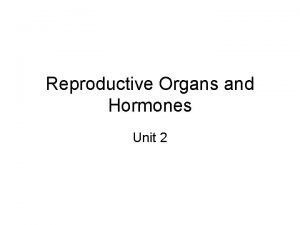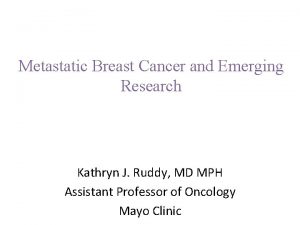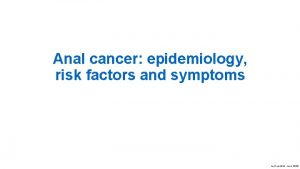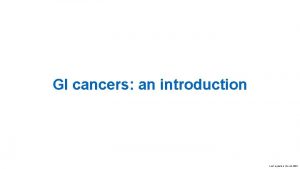GI cancers epidemiology and risk factors Last updated









- Slides: 9

GI cancers: epidemiology and risk factors Last updated: December 2019

Introduction This chapter provides a summary of: CRC, colorectal cancer; GI, gastrointestinal.

Global epidemiology of CRC remains a substantial public health challenge across the globe 1 *Percentage change in age-standardised rates. CRC, colorectal cancer. 1. GBD 2017 Colorectal Cancer Collaborators. Lancet Gastroenterol Hepatol 2019; 4(12): 913– 33. • Substantial regional and national variations exist in the incidence of CRC 1 • In many high-income countries, the burden of CRC has stabilised or declined 1 • The burden is increasing in most low- and middleincome countries, possibly as a result of ageing populations and lifestyle risk factors (alcohol, obesity, smoking and diet)1

Global epidemiology of gastric cancer Gastric cancer remains an important contributor to the global burden of cancer 1 *Percentage change in age-standardised rates. 1. GBD 2017 Stomach Cancer Collaborators. Lancet Gastroenterol Hepatol 2020; 5(1): 42– 54. • The highest incidence of gastric cancer is observed in Asia, with nearly half of cases occurring in China 1 • The absolute number of cases globally has risen since 1990 – however, age-standardised incidence and mortality rates have declined, linked to a reduction in H. pylori infection rates and rising socio-economic status 1 • The global 5 -year survival rate is ~20%; notable exceptions of 65% in Japan and 71. 5% in South Korea have been achieved by national screening programmes 1 • High-sodium diets and cigarette smoking contribute significantly to the burden of gastric cancer 1

Global epidemiology of liver cancer In contrast to the decreasing burden of many other non-GI cancers, the overall burden of liver cancer worldwide is increasing over time 1 *For HCC, the most common subtype of liver cancer. GI, gastrointestinal; HBV, hepatitis B virus; HCC, hepatocellular carcinoma; HCV, hepatitis C virus. 1. Yang JD, et al. Nat Rev Gastroenterol Hepatol 2019; 16(10): 589‒ 604 • Almost 85% of HCC cases occur in low- or middleresource countries, particularly in East Asia and sub-Saharan Africa 1 • Taiwan and Japan have the best clinical outcomes for patients with HCC, likely due to comprehensive programmes to identify high-risk adults and follow-up with intensive surveillance 1 • Chronic HBV and HCV infections are the most frequent causes of HCC, accounting for 80% of cases globally – In developed countries, non-alcoholic fatty liver disease is a major risk factor for HCC, accounting for 10– 20% of cases in the US 1 – Alcoholic cirrhosis is the second most common risk factor for HCC in the US and Europe 1

Global epidemiology of oesophageal cancer Oesophageal cancer (predominantly SCC) is the sixth leading cause of cancer-related death globally 1 SCC, squamous cell carcinoma. • The incidence of oesophageal SCC generally decreased in men during 2005– 20151 • The incidence of oesophageal SCC in women was typically lower than in men, although was rising in some countries (such as Japan, the Netherlands, New Zealand, Norway and Switzerland)1 • The incidence of oesophageal adenocarcinoma is increasing in Western populations such as Australia and the US 2 • The main risk factors for oesophageal SCC are tobacco smoking and overconsumption of alcohol, particularly in combination 1 – Trends in the incidence of oesophageal SCC in different countries may be linked to rates of smoking and levels/types of alcohol consumption 1 1. Wang QL, et al. Clin Epidemiol 2018; 10: 717‒ 28. 2. Thrift AP, Whiteman DC. Ann Oncol 2012; 23(12): 3155– 62.

Global epidemiology of pancreatic cancer Rising incidence and mortality rates for pancreatic cancer represent a major public health challenge worldwide 1 • Incidence and mortality rates for pancreatic cancer increased in almost all countries from 1990– 20171 – The highest rates are found in high-income countries 1 • With population growth and increases in longevity, further increases are expected, particularly in lowand middle-income countries 1 • Pancreatic cancer is often diagnosed at an advanced stage and responds poorly to chemotherapy, resulting in a 5 -year OS rate of ~5%1 • Causes of pancreatic cancer are not well understood, although smoking, obesity and diabetes are important risk factors 1 OS, overall survival. 1. GBD 2017 Pancreatic Cancer Collaborators. Lancet Gastroenterol Hepatol 2019 [Epub ahead of print].

Global epidemiology of anal cancer Although anal cancer represents only 1– 2% of all GI malignancies, the incidence has increased globally in recent decades 1, 2 • Social and cultural changes globally in the last few decades have resulted in increased individual exposure to risk factors such as HPV infection, HIV infection and particular types of sexual activity (such as receptive anal intercourse)1, 2 • The incidence is higher in females than in males (by as much as 5: 1) due to the higher prevalence of HPV infection 1, 2 • Although outcomes for anal cancer have improved, the 2 -year OS rate for patients with metastatic disease may be as low as 10%1 • The strong correlation between HPV and anal cancer (causative agent in 80– 85% of patients) may allow the development of effective screening and prevention programmes (e. g. HPV vaccination)2 GI, gastrointestinal; HIV, human immunodeficiency virus; HPV, human papillomavirus; OS, overall survival. 1. Salati SA, et al. Int J Health Sci (Qassim) 2012; 6(2): 206‒ 30; 2. Glynne-Jones R, et al. Ann Oncol 2014; 25(Suppl. 3): iii 10‒iii 20.

Summary: global trends in GI cancers CRC remains a substantial public health challenge across the globe; the disease burden is increasing in low- and middle-income countries Gastric cancer Age-standardised incidence and mortality rates for gastric cancer are declining, linked to improved management of H. pylori infection and rising socio-economic status Liver cancer The overall burden of liver cancer globally is increasing over time – important risk factors include HBV/HCV infection, non-alcoholic liver disease, and alcoholic cirrhosis Oesophageal cancer Rates of oesophageal SCC have been declining in men; the incidence is typically lower in women. Meanwhile, rates of oesophageal adenocarcinoma are increasing in Western countries Pancreatic cancer Rising incidence and mortality rates for pancreatic cancer, coupled with a lack of effective treatments, represent a major public health challenge worldwide Anal cancer represents only 1– 2% of all gastrointestinal malignancies, yet the global incidence has increased in recent decades due to individual exposure to risk factors such as HPV infection, HIV infection and particular types of sexual activity CRC, colorectal cancer; GI, gastrointestinal; HBV, hepatitis B virus; HCV, hepatitis C virus; HPV, human papillomavirus; SCC, squamous cell carcinoma.
 Female reproductive
Female reproductive Her2 positive cancers
Her2 positive cancers During _______ branching, only car is updated with adr
During _______ branching, only car is updated with adr Deped sample mentoring and coaching form for teachers
Deped sample mentoring and coaching form for teachers Market risk assessment
Market risk assessment Thesourceagents
Thesourceagents Nutrition epidemiology definition
Nutrition epidemiology definition Difference between descriptive and analytical epidemiology
Difference between descriptive and analytical epidemiology Incidence vs prevalence
Incidence vs prevalence Certification board of infection control and epidemiology
Certification board of infection control and epidemiology

















